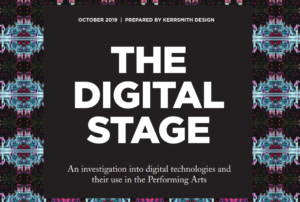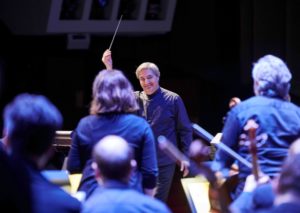Over the summer we’ll be visiting various members of the Canadian orchestral community – organizations and individuals who contribute to a thriving arts scene in Canada. If you want to write for us about your experience as an artist or arts administrator during the pandemic, get in touch with Katherine Carleton at [email protected].
A Report on the 2020 Virtual Musician Summit
Guest blog by Bradley Powell
 This past May 29th and May 30th, I attended the first-ever Virtual Musician Summit (VMS). Organized by emerging musician-entrepreneurs Noniko Hsu, Melissa Mashner, and John Hong, the VMS was an entirely online, pre-recorded conference. Thirteen 1-hour-long sessions covered topics such as audience building, productivity, public-speaking, developing online courses to generate passive income, video-creation formulas, and résumé-building, to help participants during and after the COVID-19 pandemic.
This past May 29th and May 30th, I attended the first-ever Virtual Musician Summit (VMS). Organized by emerging musician-entrepreneurs Noniko Hsu, Melissa Mashner, and John Hong, the VMS was an entirely online, pre-recorded conference. Thirteen 1-hour-long sessions covered topics such as audience building, productivity, public-speaking, developing online courses to generate passive income, video-creation formulas, and résumé-building, to help participants during and after the COVID-19 pandemic.
As our orchestras navigate current public health regulations and plan for the future, many of us are being called to find new ways to deliver and monetize our creative content. The VMS and many other educational resources are being offered to help us adapt, which presents a new problem: how to spend one’s time wisely by sifting through the plethora of pertinent offerings. The good news is that I watched all THIRTEEN HOURS of the VMS for you, on behalf of the Orchestras Canada team. Below are tips from the six presenters whose expertise is most aligned to fill knowledge gaps in our community.
Gabe Bautista | May 29, Session 1
 Former Classical Pianist and Composer
Former Classical Pianist and Composer
Current B2B Marketing
Tips for understanding marketing as a musician
- Understand and always remember that today there are a tiny fraction of people spending money on [recorded music]… even though music consumption is as frequent as ever.
- Disney as a company forecasts losing money on Disney+ until 2023; what counts is the personal relationship they are building with their clients. They have to do this in order to enter the competition with their streaming rivals. Breaking into this market is not easy, and you have to have the cash flow to sustain a reasonable amount of initial damage.
- Know that you’re in competition with the greatest musicians in the world. They’re also stuck at home. The difference is that they have thousands of followers and you may not. If you can position yourself, you can find a corner of the world that is unique to you and apply Pareto’s Principle.
- You’re also going to be in competition with everyone who’s dead!
- Even the Taylor Swifts of the world don’t make the majority of their money from the masses; Again, remember Pareto’s Principle
- The most important people to you are those you support you 100%. If you can have 1000 true diehard fans, you can make a living. It’s not about the million 10% fans.
- You’ve gotta do whatever you need to do NOW because the new normal is what we’re experiencing. Returns to pre-pandemic venues are far off; even after a vaccine it still won’t be immediate because implementation will take time.
- Sunk cost fallacy: the more costs we’ve invested, the less we want to give up our paths. We need to accept that some of our assumptions are wrong. We need to embrace change.
- If you’re a creative, then BE CREATIVE. Some people just show up (to an orchestra rehearsal for example) and do as they’re told. Our industry is creative – go out and create!
- Read [Bautista’s] book “Most Businesses Fail Within The First Five Minutes. It just takes them 3-5 years to realize”
- Everyone wants to be unique, but no one wants to be different. We don’t wanna cause any trouble. For you to stand out… you have to stand out!
- Remember the rule of “and”: every time you say, “I do this And this And this,” that doesn’t multiply your talents, it divides them. Be careful about taking on too much. Limit how you describe your offerings to your public so your value proposition is clear.
Marley Jaxx | May 29, Session 2
 CEO of Video Marketing Agency Jaxx Productions
CEO of Video Marketing Agency Jaxx Productions
Has worked alongside Gary Vaynerchuk, Seth Godin, and Randi Zuckerberg
Tips for how to market your online content
- Form [what Jaxx calls] a True Fan base. People become “overnight successes” because of, in part, the community that they build around them. This often means that true fans have been recruiting other fans and the exponential increase in following happens at a tipping point. Getting to that tipping point requires fans that will support you, no matter what.
- You don’t have to spend a lot of money to start learning; Jaxx started through YouTube, where she watched free videos and learned skills until she was ready to invest in courses that cost money.
- You have to start to be able to find your voice. Don’t put up arbitrary obstacles for yourself like “I just need to be bigger; I just need to be a bit better.” before starting. Don’t worry if there are others putting up very similar content. Your start in video posting is as much for you to find your voice online as it is for developing a following. And your unique voice is really what will resonate with people watching your videos. We like to follow people who are relatable.
- You have to make a conscious decision to be vulnerable as you begin to post videos for the first time.
- The market will tell you what people need. Don’t assume you know what people need or don’t need. Test your content, and then go in the direction that your audience is asking for.
Ken Kubota | May 29, Session 4
 Cellist, founder of viral Instagram and YouTube success JHMJams
Cellist, founder of viral Instagram and YouTube success JHMJams
Recognized in Glamour, The Strad and much more
Tips for ‘going viral’ with online music performances
- Kubota has not missed a weekly deadline for this project ever; that means 4 years of meeting personal deadlines for the project. Consistency is king!
- Started his project as part of an Intro to Technology course at Juilliard while he was in graduate school.
- Announced to the world he’d post every Tuesday and Friday and creatively works to meet that; He began posting short cover-performances of songs every week.
- Find a void missing in your own life; Kubota was losing sight of why he was a cellist in school, and the downward spiral of his mental health during classical music education motivated him to find a new path.
- Make sure the fuel you’re using to drive your musicianship is sustainable. A lot of what Kubota was doing early in his training was driven by fear.
- Four Step Process to Cultivate Motivation for Consistency by Finding What You Really Want and Are Intrinsically Motivated By:
- Cue: What reminds you that your goal exists?
- Craving: What makes a project attractive to you?
- Response: What are you going to do to make this “easy” for you?
- Reward: What will make this satisfying for you when you put in this work?
- Eliminate as many obstacles to your consistency as you can
- Suggested Reading
- Atomic Habits by James Clear
- Time to Log Off – How To Do Dopamine Fasting Right; Engage in a Dopamine/Digital Detox!!!
- Patreon is a very effective and personal platform for creators (better than YouTube); avoid begging for money and instead provide a worthwhile value proposition.
- Understand the concept of compound interest [as applied to marketing] and how it can propel the growth of your following.
John Hong | May 30, Session 2
 Performing Arts Copywriter, Former National Sawdust PR Manager
Performing Arts Copywriter, Former National Sawdust PR Manager
Clients include nonprofit CEOs to US orchestra
Executive Directors to GRAMMY® winners
Tips for eye-catching text
- What does writing good copy mean?! If you can communicate authentically you’re much more likely to convince someone to support you than if you try to sell in the showmanship style.
- For Hong, a job in door-to-door sales (alarm systems) led to PR for National Sawdust (all learning on his feet). He had to convince people he was trustworthy enough to let him into their homes… to talk about alarms. Succinct, trustworthy communication style is key!
- Diversify your income, even if it’s business as usual in your sector. As an example, only 10% of noted performance psychologist Noe Kageyama’s income comes from his Juilliard faculty position; most of it comes from his website.
- Good copywriting can actually convince audiences to come to concerts. It’s important.
Jacques Hopkins | May 30, Session 3
 Founder of 7-figure online empire PianoIn21Days
Founder of 7-figure online empire PianoIn21Days
From an engineer to a proven piano pedagogy course builder
Tips for building passive income from online music courses
- Youtube is a search engine! Remember that. Consistent quality will pay off in the end. People will be able to access older content as you gain a following, and that can become a great source of passive income.
- Running an online business involves knowledge of complex tech. Partner with someone if that side doesn’t come naturally to you.
Jade Simmons | May 30, Session 7
 Concert Pianist, Motivational Speaker, Entrepreneur
Concert Pianist, Motivational Speaker, Entrepreneur
Former Miss America Runner-up, “A magnetic personality worth seeing” — The Washington Post
The most compelling speaker at the VMS was Jade Simmons. Her entire message centres on the fact that classical music can be invigorated simply by each one of us making space for more creativity and individuality. In a ‘creative’ field which has told us to blend in, to compare ourselves to others, and to be the fastest and loudest so we can win a stable income, we have lost touch with our desire and ability to tell our unique stories. We have the potential to gain momentum if we focus on moving others. Communication with our audiences will compel larger, more diverse groups to support our story-telling.
I encourage you to watch her 2015 TedTalk. Watch all 18 minutes. It’s worth it. You can learn more about Simmons here.
According to its website, the VMS is “A two-day event where proven musician-entrepreneurs unveil step-by-step techniques to get an edge in marketing concerts, building your own social media content, building online streams of income that you can rely on during troubled economic times, and much, much more.” In attending this summit organized by and for a young, diverse group of musician-entrepreneurs, I believe that the orchestra community has a lot to learn, but that there’s a ton of untapped potential within our sector that we can access to adapt and thrive during a time of crisis. *
* “Let’s get this bread”, as used by The Youth, means ‘let’s get to work and make that money, honey.’ I’m trying to blend in with Gen Z. The children are our future.



